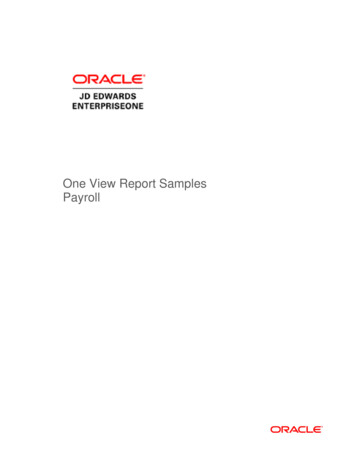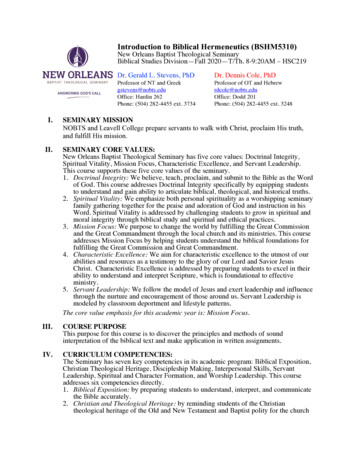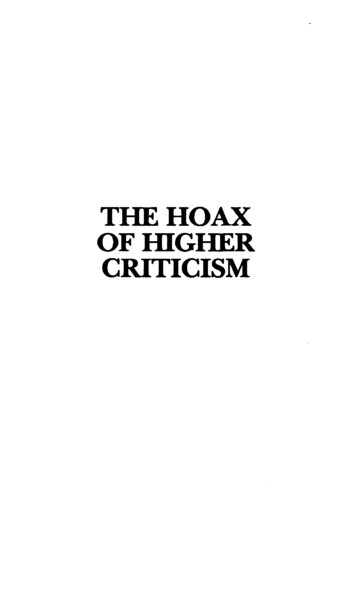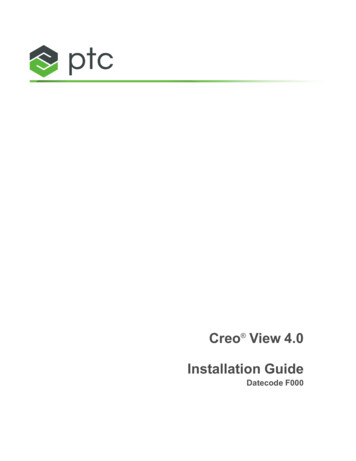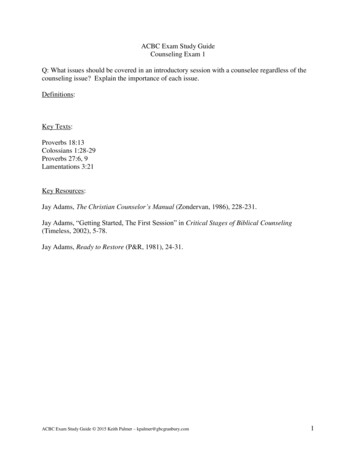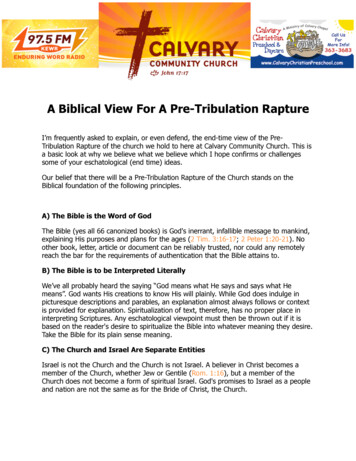
Transcription
A Biblical View For A Pre-Tribulation RaptureI’m frequently asked to explain, or even defend, the end-time view of the PreTribulation Rapture of the church we hold to here at Calvary Community Church. This isa basic look at why we believe what we believe which I hope confirms or challengessome of your eschatological (end time) ideas.Our belief that there will be a Pre-Tribulation Rapture of the Church stands on theBiblical foundation of the following principles.A) The Bible is the Word of GodThe Bible (yes all 66 canonized books) is God's inerrant, infallible message to mankind,explaining His purposes and plans for the ages (2 Tim. 3:16-17; 2 Peter 1:20-21). Noother book, letter, article or document can be reliably trusted, nor could any remotelyreach the bar for the requirements of authentication that the Bible attains to.B) The Bible is to be Interpreted LiterallyWe’ve all probably heard the saying “God means what He says and says what Hemeans”. God wants His creations to know His will plainly. While God does indulge inpicturesque descriptions and parables, an explanation almost always follows or contextis provided for explanation. Spiritualization of text, therefore, has no proper place ininterpreting Scriptures. Any eschatological viewpoint must then be thrown out if it isbased on the reader's desire to spiritualize the Bible into whatever meaning they desire.Take the Bible for its plain sense meaning.C) The Church and Israel Are Separate EntitiesIsrael is not the Church and the Church is not Israel. A believer in Christ becomes amember of the Church, whether Jew or Gentile (Rom. 1:16), but a member of theChurch does not become a form of spiritual Israel. God's promises to Israel as a peopleand nation are not the same as for the Bride of Christ, the Church.
D) A Literal 1000-Year MillenniumThe Bible describes a future, literal 1000-year time period. The Greek word "chilias" for"one thousand" appears six times in Revelation 20, clearly marking the time period ashaving 1000 literal years. The purpose of this time period is for Jesus Christ to have anearthly kingdom from which to base His rule and to fulfill His promises (Gen. 13:14-17;15:5,18-21; 2 Sam. 7:16-19; Isa. 10:21-22; 11:1-2; Jer. 23:5-8; 30:22; 31:31-34; Ezek.11:18-20; 34:24; 36:24-28; Mic. 7:19-20; Hos. 3:5; Rom. 11:26-29).E) A Literal 7-Year TribulationAn upcoming time period has been set aside for God to pour out His wrath upon the evilof the world, to regather Israel back into its land, to force Israel to acknowledge Jesusas their Messiah, and for the Messiah to return and fight for His believing remnant(Deut. 4:26-31; Isa. 13:6-13; 17:4-11; Jer. 30:4-11; Ezek. 20:33-38; Dan. 9:27; 12:1;Zech. 14:1-4; Matt. 24:9-31). This time period begins with a covenant between Israeland the Antichrist (Dan. 9:27). The length of the Tribulation is seven years long,described in a variety of ways as "one seven" year block (Dan. 9:27), consisting of two"times, time and half a time" (two years 1 year half a year; Rev. 12:14), or two"1260 days" periods (Rev. 11:3), or two "42 month" periods (Rev. 11:2; 13:5).F) Jesus Will Return Again to EarthThe Bible says Jesus will physically return again to earth (Zech. 14:1-21; Matt.24:29-31; Mk. 13:24-27; Lk. 21:25-27; Rev. 19). Jesus returns is to defeat His enemies,set up His throne, restore Israel, rule with "a rod of iron" and share His authority withthose who overcame in Him (Mat. 19:28; 25:31; Acts 1:3-6; Rev. 2:26-27; 3:21).G) The Bible Teaches About a Rapture1 Thessalonians 4:17 speaks of an event called "the Rapture", Latin "rapio," Greek"harpazo," which means "to catch up, to snatch away, or to take out." "Then we whichare alive and remain shall be caught up together with them in the clouds, to meet theLord in the air: and so shall we ever be with the Lord." Paul states that the concept ofthe Rapture is meant to encourage believers during this Age (1 Thes. 4:18). Other NewTestament references on the Rapture are Jn. 14:1-4; I Cor. 15:51-58; and 1 Thes.4:13-18.The above statements about the Bible and its interpretation provide the foundation inwhich to analyze the following reasons for why I believe the Bible teaches a PreTribulation Rapture of the Church.
1) The Bible describes the Rapture and Second Coming as differentevents.The Bible must see the Rapture (Jn. 14:1-4; I Cor. 15:51-58; 1 Thes. 4:13-18) and theSecond Coming (Zech. 14:1-21; Matt. 24:29-31; Mk. 13:24-27; Lk. 21:25-27; Rev. 19)as separate events, because when the verses are compared they describe two verydifferent scenarios:1.Rapture — believers meet Christ in the airSecond Coming — Christ returns to the Mt of Olives to meet believers on earth2.Rapture — Mount of Olives is unchangedSecond Coming — Mount of Olives is divided, forming a valley east of Jerusalem3.Rapture — living believers obtain glorified bodiesSecond Coming — living believers remain in same bodies4.Rapture — believers go to heavenSecond Coming — glorified believers come from heaven, earthly believers stayon earth5.Rapture — world left unjudged and living in sinSecond Coming — world is judged and righteousness is established6.Rapture — depicts deliverance of the Church from wrathSecond Coming — depicts deliverance of believers who endured wrath7.Rapture — no signs precede itSecond Coming — many signs precede it8.Rapture — revealed only in New TestamentSecond Coming — revealed in both Old and New Testaments9.Rapture — deals with only the savedSecond Coming — deals with both the saved and unsaved10. Rapture — Satan remains freeSecond Coming — Satan is bound and thrown into the AbyssSince the Rapture and Second Coming clearly are different events that do not occur atthe same time, this would seem to rule out a Post-Tribulation Rapture scenario.
2) The Rapture is described as occurring at any time without warning.Jesus stated in Matthew 24:42,44 to "Watch therefore: for ye know not what hour yourLord doth come. Therefore be ye also ready: for in such an hour as ye think not theSon of man cometh." Not only do believers in Christ not know when to expect Him, butthe Father Himself seems to have left Jesus out on the exact time His Son is to return.As Jesus stated in Matthew 24:36, "But of that day and hour knoweth no man, no, notthe angels of heaven, but my Father only." These and other verses (Mat24:36,42,44,50;25:13; 1 Thes. 4:18; Tit. 2:13; 1 Jn. 2:28; 3:2-3) indicate that Jesus' arrival will comewhen nobody expects it.The Second Coming, on the other hand, is preceded by many events, such as the riseof the Antichrist (Rev. 12:13-17; Zech; 13:7-9), a treaty with Israel (Dan. 9:27), therebuilding of the Jewish Temple (Mat. 24:15; 2 Thess. 2:3-4; Rev. 11:1-2), as well asplagues and judgments and persecutions destroying most of the world's population(Rev. 6-18). The Book of Revelation reports these events as occurring during the 7-yearTribulation, which Revelation reveals precede the Second Coming.Because the Rapture could happen at any moment and without warning and the SecondComing is preceded by so many signs, then the Rapture and Second Coming must bedifferent events. The Rapture has to occur before the seven years' worth of signs,because Christians are called to look for the Lord's return rather than signs such as theAntichrist's arrival. Once the signs begin, then the seven year countdown beginstowards its end with Christ's return at the Second Coming.Jesus' imminent return dismisses any of the other viewpoints related to a rapture thatoccur within or at the end of the Tribulation.3) The Rapture and the removal of the "Restrainer" occur at the sametime.In 2 Thessalonians, the church at Thessalonica was afraid due to a false report thatthey had entered the Day of the Lord (Tribulation) and had somehow missed theRapture. The Apostle Paul assured them that the Antichrist would not be revealed untila restraining force would be taken away so that the Man of Lawlessness could berevealed.Because the revealing of the Antichrist coincides with the beginning of the 7-yearTribulation starting with his peace treaty with Israel (Dan. 9:27), then the Restrainerhas to be removed before the Tribulation. As the Holy Spirit also works in salvation (Jn.16:8-11; 1 Jn. 5:7) during the Tribulation, then it is the Church that must be theRestrainer that is removed. Therefore, the Rapture and the removal of the Church mustcoincide, and at the beginning of the seven years.
4) The Tribulation is for Israel’s redemption.Jeremiah 30:7 describes the Tribulation as the "time of Jacob's trouble" — "Alas! forthat day is great, so that none is like it: it is even the time of Jacob’s trouble; but heshall be saved out of it."In the Book of Matthew, whose primary audience is the Jews, Jesus explains to hisJewish followers what life will be like during the Tribulation. Also, Revelation 12describes picturesquely a woman who gives birth and has to flee due to persecutionduring the Tribulation. The context shows the woman is Israel. And again, the Battle ofArmageddon is the world against Israel. Two-thirds of the Jewish people will be killedfrom these battles. These texts and others show that the Tribulation is meant for theredemption of the Jewish people.Why are the Jews the object of persecution during the Tribulation? It’s possible Satanhates the Jewish people for giving the world the Scriptures and the Messiah, as well ashe wishes to thwart God's promises to the Jews. Secondly, the Jews have to be sodesperately brought low that they finally call out to their Messiah "Blessed is he whocometh in the name of the Lord" (Mat. 23:39; Lk. 13:35). The Tribulation, then, is usedfor Israel's redemption which also results in the punishment of the wicked. The Churchdoes not fit into this scenario, and are left out of the purposes of the Tribulation. Theywould need to be removed — caught up — before the Tribulation begins.5) The Tribulation is not for the Church.The Tribulation is God's wrath upon the unbelieving world, and not for those who aresaved from Christ's resurrection to the Rapture — called the Church. Yes believers havesuffered all throughout human history, but there is a special time (just like the Flood)set apart called the Day of the Lord for God's wrath. Christians suffering and theTribulation/Day of the Lord are different.True believers in Christ during the Church Age, represented by the Church ofPhiladelphia, are promised in Revelation 3:10, "Because thou hast kept the word of mypatience, I also will keep thee from the hour of temptation, which shall come upon allthe world, to try them that dwell upon the earth." Paul states in 1 Thessalonians 1:10,"And to wait for his Son from heaven, whom he raised from the dead, even Jesus,which delivered us from the wrath to come." He also states in 1 Thessalonians 5:9, "ForGod did not appoint us to suffer wrath but to receive salvation through our Lord JesusChrist." Romans 5:9 states, "For God hath not appointed us to wrath, but to obtainsalvation by our Lord Jesus Christ!" Ephesians 5:6 states, "Let no man deceive you withvain words: for because of these things cometh the wrath of God upon the children ofdisobedience." Colossians 3:4 states, "When Christ, who is our life, shall appear, thenshall ye also appear with him in glory." Again and again, Scripture states the Church isnot meant to endure God's wrath.
6) God's wrath involves the whole 7-Year Tribulation.The view that the Rapture will occur at the mid-point of the Tribulation is based upon 1Corinthians 15:52 which states that the Rapture will occur at the blowing of "the lasttrumpet." This Mid- Tribulation Rapture view then declares this trumpet to be the last ofthe seven trumpets in Revelation 11 that is blown at the mid-point of the Tribulation.Why of the 114 references to trumpets in the Bible these two are identified as one andthe same only defies sound Bible study. The context clearly shows the last trumpet of 1Corinthians 15 is blown for believers whereas the seven trumpets of Revelation 8, 9 and11 are sounded for unbelievers. The Revelation trumpets therefore can have norelevance for the Church.The Pre-Wrath Rapture view has the Church raptured just before the bowl judgments(Revelation 16) that occur during the last quarter of the Tribulation. The bowljudgments are the only judgments this view considers to be the wrath of God, leavingthe Seal and Trumpet judgments as wrath from man and Satan. But, isn't it JesusHimself who breaks the seals that launch each of the Revelation 6 seal judgments whichoccur at the beginning of the Tribulation? Also, the seven angels who blow the trumpetsthat initiate each of the trumpet judgments are given their trumpets at the throne ofGod (Revelation 8:2). And, Revelation 15:1 states that the bowl judgments at the endof the Tribulation finish the wrath of God, not begin His wrath.Because these judgments are initiated by Jesus Himself at the beginning of theTribulation, the whole Tribulation must be God's wrath, which the Church is exemptfrom.7) The Old Testament and Revelation leave the Church out of theTribulation.The focus of the Tribulation — to pour out God's wrath on the earth just like the Flood(Isa. 24:22; Zeph. 3:8; 1 Thes. 5:3; 2 Thes. 2:12) and to bring the Jewish people toaccept Jesus as Messiah (Mat. 23:39; Lk. 13:35) — is addressed by the Old Testamentand the Book of Revelation to the unbelievers and the Jewish people. In any biblicalcontent concerning the Tribulation/Day of the Lord, the Church cannot be found.The whole concept of the Church was a mystery to the Old Testament prophets. Theyfocused on the nation of Israel. The Book of Matthew is written to the Jewish people,whom Jesus is addressing in Matthew 24. In the Book of Revelation, chapters 2 and 3cover the Church Age, but then there is no mention of the Church until after theTribulation/Day of the Lord chapters 6-18. In Chapter 19, the Church returns to thetexts and can be found, not suffering, but celebrating with Christ at the MarriageSupper of the Lamb and preparing to return with Jesus to earth.
8) The Church is busy elsewhere during the Tribulation.While the 7-year Tribulation is occurring, the Bible records the Church will be busy withthree events. None of the three have to do with suffering on a world being destroyed.The first event the raptured Church will participate in is a judgment by God — theJudgment of the Just. This judgment on works is not to determine eternal destiny, butto determine degrees of reward (2 Cor. 5:10; Rev. 19:6-9).The second event is the Marriage Supper of the Lamb. This feast celebrates the spiritualmarriage of Christ's Bride — the Church — to her Savior. Revelation 19:7-9 shares thiswonderful celebration, "Let us be glad and rejoice, and give honour to him: for themarriage of the Lamb is come, and his wife hath made herself ready. And to her wasgranted that she should be arrayed in fine linen, clean and white: for the fine linen isthe righteousness of saints. And he saith unto me, Write, Blessed are they which arecalled unto the marriage supper of the Lamb. And he saith unto me, These are the truesayings of God.'"The third event follows the Marriage Supper of the Lamb and is the Church'spreparation to follow the King of Kings into the Battle of Armageddon at the conclusionof the Tribulation. This event is the Second Coming of Jesus Christ (Zech. 14:1-21;Matt. 24:29-31; Mk. 13:24-27; Lk. 21:25-27; Rev. 19:11-21). Revelation 19:14 identifiesthe Church in their "fine linen, white and clean," which was given to them during thefirst event — the Judgment of the Just. The Church and angelic forces follow the Kingof Kings into His Second Coming to the earth, but only Jesus Himself will engage inbattle and with mere words defeats the nations in siege against Jerusalem.9) There needs to be sheep to separate from the goats.If the Church is raptured at the end of the Tribulation, receives their glorified bodies,and then immediately u-turns back with Christ for the Second Coming as the PostTribulation Rapture view holds, then what believer in Christ will be available for theSheep and Goats Judgment of Matthew 25? The only people left on earth would beunbelievers, called goats. No believer — sheep — would be available for God to put intothe sheep category.Since those who are in glorified bodies will be like the angels in that they aren't given inmarriage or reproduce (Matt. 22:30; Mk. 12:25), then a believing, unglorified, humanremnant must make it into the sheep category and go on to produce the nations duringthe Millennial reign of Christ (Ezek. 43:13-27; Isa. 19:21; Isa. 65:20-22; Rev. 20:7-10).This would mean that people would need to come to Christ during the Tribulation yetafter the Rapture to produce this Millennial population.
10) The Bible shows God rescues the righteous from His wrath.Being a Christian means having to endure suffering and trials at the hand of man (Jn.16:33; Phil. 1:27; 1 Thes. 3:3; 1 Pet. 4:12-13). But, the Bible has many examples ofthose who put their faith in God are exempt from God's wrath. Noah and his familywere removed from the Flood waters that in God's wrath were used to judge andcleanse the earth. Lot and his wife and two daughters were made to leave Sodom andGomorrah before God burned the towns up with fire and sulfur. Rahab's family was setapart when Joshua's army invaded Jericho.Could believers be miraculously protected during the Tribulation, like the Israelites wereduring the plagues on Egypt? Yes, the 144,000 Jewish evangelists from Revelation 7and 14, for instance, will be divinely protected. But, the slaughter of believers duringthe Tribulation will be so massive that they are certainly not under any specialprotection (Rev. 7:9-17; 20:4).11) The Pre-Tribulation Rapture view is not too new to discount.Some argue that the Pre-Tribulation Rapture view is just "too new" to be consideredviable. Critics will point to the origin of the modern Pre-Tribulation view and credit JohnNelson Darby (1800-1882) with its founding. But, is that assessment historicallyaccurate? No.In the early church writings (the Gospels and Epistles) there are numerous referencesto the imminent return of Jesus Christ, a central argument for the Pre-TribulationRapture view.Biblical truth is determined by Scripture, and not how that teaching has been perceivedat different times during history. When Augustine falsely began spiritualizing the Bible,his view of a non-literal interpretation took hold of the church until the Renaissance,obliterating the Premillennial and Pre - Tribulation Rapture views in favor ofAmillennialism. But, there are many others that distinguish the Rapture from the SecondComing.When the chains of allegorical interpretation began to fall off beginning with theReformation in the 1400 and 1500s, writers such as Joseph Mede (1586-1638),Increase Mather (1639-1723), Peter Jurieu (1687), Philip Doddridge (1738), John Gill(1748), James Macknight (1763), Thomas Scott (1792) and Morgan Edwards(1722-1795) all wrote concerning the Rapture occurring separate from the SecondComing. Even in the more modern church, those like William Witherby (1818) wereprecursors to John Darby in support of the view. The Pre-Tribulation Rapture view isindeed then not only biblical, but supported throughout Church history.
Closing ThoughtsAfter reading this please take time to go before God in prayer, asking Him to reveal toyou the truth surrounding the imminent return of Jesus Christ! You have to weigh outthe Word of God and decide for yourself (on God’s leading) what you believe God’sWord is saying. Please remember, your end times views have no bearing on the basicdoctrines of Salvation. Prayerfully we can all agree that through the gift of salvation wewill one day be caught up to be with our Lord and Savior Jesus Christ for all of eternity.
The Bible (yes all 66 canonized books) is God's inerrant, infallible message to mankind, explaining His purposes and plans for the ages (2 Tim. 3:16-17; 2 Peter 1:20-21). No other book, letter, article or document can be reliably trusted, nor could any remotely reach the bar for the

